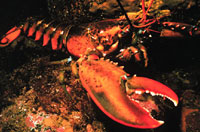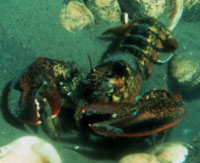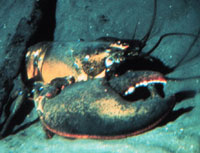Richard A. French, a specialist in animal disease at the University of Connecticut, often comes to work wearing a lobster tie tack he bought at a shellfish conference. He’s had lobsters on the brain lately, particularly the mystery of why hundreds of thousands of lobsters have died within the last year in Long Island Sound.

In a sea of troubles.
Photo: OAR/NURP.
In the western end of the Sound, which separates Connecticut from Long Island’s north shore, lobster landings went from historic highs in late 1997 to a nearly collapsed stock two years later. Beginning in the fall of 1999, lobster trappers in the area, off Greenwich, Norwalk, and Bridgeport, Conn., reported that from 60 to 99 percent of the market-sized lobsters showing up in their pots were dead.
By late 1999, the problem had spread eastward to encompass the entire Sound. Although just a year before the Sound had supported a $42 million-a-year lobster industry, lobster boat owners were beginning to talk about getting out of the business.
The lobster tragedy comes at a time when Long Island Sound’s water is cleaner than it has been in decades, and a few years after Connecticut and New York agreed to make expensive improvements to their sewage-treatment plants to cut nitrogen outflows, thus helping to keep the oxygen in the Sound at healthy levels.
At first, many people found comfort in the theory that heavily populated New York City, with older sewage treatment plants that overflowed more often, was the culprit. But then the problem spread to the eastern end of the Sound — and the mystery deepened.
Tray Chic
Even when he’s cutting up a dead animal, French’s shirt is starched, his hair slicked back, and his Nike sneakers spotless. The energetic 40-year-old looks as if he’s ready for a game of pick-up basketball.

Sink or swim?
Photo: P. Auster, OAR/NURP.
For the last nine months, French’s job has often taken him out of his laboratory in Storrs, Conn., and down to the coast, where he interviews fishermen whose lobster pots are full of dead crustaceans. On the days he’s in the lab, he examines tray after tray of lobster tissue slides.
He has found the same microscopic parasite in every dead lobster. The parasite is one scientists hadn’t seen before, a protozoan that they believe to be a paramoeba. For all its apparent tenacity inside the lobsters, the paramoeba can’t survive in a laboratory culture, so researchers have had difficulty studying it.
French and his colleagues don’t know why lobsters can’t fight off this parasite the way they fight off other things. They suspect that another factor, possibly pollution, is making lobsters succumb to the paramoeba.
Many lobsters in Long Island Sound that aren’t dead have been suffering from another affliction known as shell disease. Almost all of the lobsters trapped in the eastern end, where the Sound meets the Atlantic Ocean, have the mottled shells caused by this illness, even the young ones. Shell disease doesn’t affect lobster meat, but in advanced stages it kills the animals.
Dead in the Water
Last year, congressional members from Connecticut and New York asked for millions of dollars in disaster relief and funding for lobster research in the region, but the bill died in the House in late spring. French shrugs this off. “I guess that’s politics. I try to keep a distance from that,” he said.

Lobster in deep water.
Photo: R. Cooper, OAR/NURP.
In late May, French, four other scientists at UConn, and two fisheries officials got a smaller pot of money for research, about $98,000 from the U.S. EPA’s Long Island Sound Study program. French will lead the team in conducting the first major study of lobsters in the area.
“There’s never been a routine health assessment of the lobster population of the Sound,” French said. “The lobster may be a sentinel for the conditions of the Sound.”
The scientists hypothesize that lobsters are dying from other diseases besides the parasite, and that these pathogens do more damage because of environmental stressors such as warmer water, changes in habitat, or contaminants in the Sound. For the next year, French and his colleagues will examine tissue from 10 lobsters each week, looking for signs of the paramoeba, pesticides, shell disease, and other problems.
Not Just a Lobster Tale
One of French’s new duties is to face the public. As the leader of the lobster study team, he meets not only fishermen but also angry environmental advocates and pushy reporters. But he said his public role doesn’t bother him. It reminds him of the years he spent in Illinois as a veterinarian, when he’d have to explain to someone why their beloved dog was very sick.
On top of his work with lobsters, French has other ill animals to worry about. Last year he developed a new test to detect a disease that’s afflicting oysters in the region. And in the midst of the lobster dilemma, he had to find time to perform necropsies on hundreds of crows that had fallen dead in Connecticut, victims of the West Nile virus, a mosquito-borne illness that killed seven people in New York City last year.
Two nights in one recent week, after eating dinner with his wife, Darla, and their three children, he returned to work at the lab — until 2 a.m. one night, then 3 a.m. another. His nighttime tasks include correcting tests for courses he teaches. “I spend my after hours doing what I used to do during the day,” he said.
But he loves his work, even if the hours are long and all the attention hasn’t made him rich. Wild animals don’t have owners, he points out, so a veterinary pathologist lives under the obligation to take care of them.


